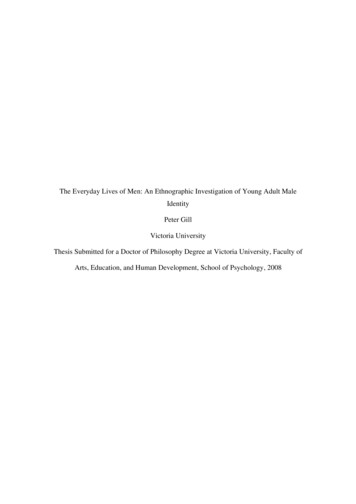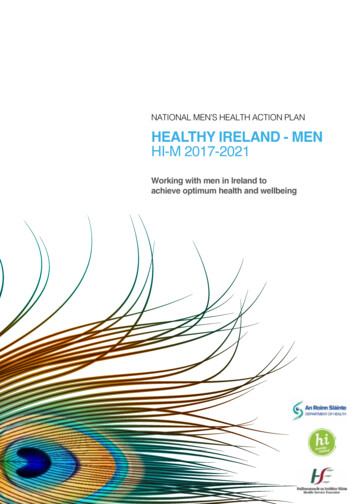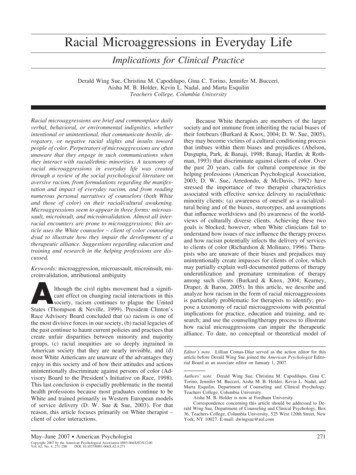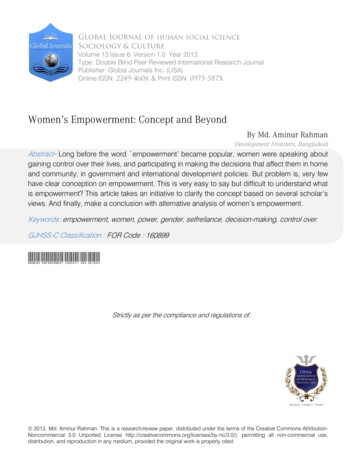
Transcription
The Everyday Lives of Men: An Ethnographic Investigation of Young Adult MaleIdentityPeter GillVictoria UniversityThesis Submitted for a Doctor of Philosophy Degree at Victoria University, Faculty ofArts, Education, and Human Development, School of Psychology, 2008
Everyday Men iiAbstractThere has been increasing social debate in recent times surrounding men’s identities,men’s health and wellbeing, and men’s place within contemporary western society.The purpose of this thesis was to contribute to new knowledge of these issues throughan ethnographic exploration of two small sub-cultures of young adults. Utilisingparticipant observation the researcher described in detail the ways in whichmasculinities were constructed in everyday life. The researcher spent over 2 years as aparticipant observer of a small group of men from a gymnasium in Melbourne, whichfollowed a briefer but still illuminating period spent with a group of men from a smallcommunity in Australia. An ethnographic approach and a non-clinical and nondeviant sample were used to build in-depth knowledge from a neutral lens that did notassume an existing male deficit or crisis.The major findings revolved around the complexity of the male socialnetworks, including the men’s need for belonging and in particular same sexfriendships, the implicit and explicit rules of engagement, rational reflectivediscussion, and male engagement in their social worlds. In addition this thesisilluminated the salient masculine discourses for constructing and negotiatingidentities, which included heterosexual attraction, competition and social comparison,and biological predispositions and simplicity.This thesis also presents a dynamic psychosocial theory of male identity, andillustrates the relevance of this theory to the everyday lives of men. The men wereshown to both collectively and individually negotiate and construct their identities byutilising the key processes of identification, sublimation, and reflection. By combiningboth phenomenological and discursive research methods the researcher was able toillustrate in everyday life the dialectic between the social and subjective elements ofidentity.The researcher also discusses the challenges he faced as an ethnographicfieldworker, and contributes to the development of improved understandings of thepractical requirements of fieldwork, such as time, support, and flexibility.
Everyday Men iiiAcknowledgementsThankyou to my supervisor Marion Kostanski for her support, guidance, and hardwork over the last 5 or so years. Marion’s supervision has helped me to criticallyevaluate and push the boundaries of known theory and practice, develop my writingand reporting techniques, and develop an academic career.I’d like to thank my associate supervisor Chris Sonn for his continued guidance andsupport over the last 5 last years. Chris was particularly helpful in developing,analysing, and understanding this project.I’d like to thank the participants of this study for their friendship and invaluablecontributions.I’d also like to thank Lutfiye Ali, Joe Losinno, Andrew Jago, Romana Morda, andKerry Gill who all made significant contributions.In addition, I’d like to thank all my friends and family for supporting me through thisprocess.
Everyday Men ivDeclarationsI, Peter Gill, declare that the PhD thesis entitled ‘The Everyday Lives of Men: AnEthnographic Investigation of Young Adult Male Identity’ is no more that 100,000words in length including quotes and exclusive of tables, figures, appendices,bibliography, references and footnotes. This thesis contains no material that has beensubmitted previously, in whole or in part, for the award of any other academic degreeor diploma. Except when otherwise indicated, this thesis is my own work.Signature.Date.
Everyday Men vTable of s .ivTable of Contents.vList of Tables .viiiList of Figures .ixPreface .ixGlossary of Australian Slang .xChapter 1.11Introduction.11Epidemiological Data.11Gender Role Theory.12Developmental Theory.13Social Constructionist Theory.14Dynamic Psychosocial Identity Theory .14Aims.15Design .16Contribution to Knowledge.16Thesis Overview .17Chapter 2.19Revisiting the World of Men .19Crisis of Masculinity? .22Men’s Physical Health and Well-Being.23Men’s Psychological Health and Well-being .27Consistencies.28Changes.28Male Emotions .30Male Friendship .34Summarising Men’s Health Statistics.35Young Men .36The Rural Setting .37Summary .39Chapter 3.41A Dynamic Psychosocial Theory of Identity and Well-being .41Cornelius Castoriadis .42The Psychoanalytic .43Relational/Interpersonal Aspects .44The Developmental.45Social Learning Aspects .45Overall.46Reflectivity.47Identity .49Identity and Psychosocial Well-being .52Summary .59Chapter 4.61Psychosocial Identity Development in Early Childhood .61Birth .63Triadic Phase.65
Everyday Men viOedipal Phase.66Sublimation Phase.72Summary .74Chapter 5.77Reflecting on Practice: Negotiating the Competing Needs of Participants,Researcher, and Institution.77Connecting the Social and the Psychological through Fieldwork .78Critique of the ‘known’ Process .81Chapter 6.92Methodology .92Ethnographic Description .92Summary .93Context and Participants .93Data Collection .95Participant Observation and Focus Groups.95Participant Observation and Individual Interviews.97Analysis.98Participant Observation and Focus Groups.98Participant Observation and Individual Interviews.101Participant Validation .102Researcher’s Positioning.103Chapter 7.104Contextualising the Subcultures of Men.104Study 1: Men in the Rural Village .104Study 2: Beyond the Grunt, the Men of the Gym .108Study 2: Ethnographic Participant Observations and Description.112Chapter 8.114The Characters .114Stan the Wedding Leper.114Profanity Aaron.117The Golden Greeks .118My Brush with Celebrity .121The Computer Technician.122The Mighty Hawks .124Grumpy Old Men.127Reflections on the Group ‘Fit’ .129Positioning the Data.131Chapter 9.133Men Talk.133Conversational Style and Language.134Motivations and Behaviours .140Shared Values .149Defining Man (Masculine Discourses) .158Summary .165Chapter 10.169Discussion .169Dynamic Psychosocial Male Identity .171Overview.176Skills and Competencies .177Connection with Friends and Friendship Circles.179
Everyday Men viiIntimate Relationships .183Independence and Autonomy .186Reflectivity.188Chapter 11.191Conclusion .191Approach.191Findings.192Limitations and Future research.196Implications.196References. 197
Everyday Men viiiList of TablesTable 1.Early childhood developmental transformation from primaryimagination to social imagination62Table 2.Methodological Summary94Table 3.Summary of Findings: Conversational styles, motivations andbehaviours, and discourses134Table 4.The three major lenses for conceiving of men’s well-beingcontextualised by the Process of Dynamic Psychosocial Reflection 173
Everyday Men ixList of FiguresFigure 1Age specific suicide rates per 100,000 population 200536PrefaceThis thesis contains some strong language that might offend. In order to accuratelyrepresent the everyday lives of men, the author included excerpts which sometimescontain strong language.
Everyday Men xGlossary of Australian SlangSlang Word/PhraseMeaningbowl bronzersomeone who makes a mess on the toiletbutchmasculine femalecausebecausechip on their shouldersomeone who is defensivecuntderogatory term e.g. worse than Assholedingotype of Australian dogdoonablanket, quilt, duvetemthemfor’emfor themgeezjesusget’emget themgottagot togunnagoing tomuck aroundmess aroundnutstesticlesold manfatheron tapto have unlimited access topea heartmentally week in competitive situationsputting on sizegaining muscle densitysayinsayingsnubbedto ignoresoft/week as pissmentally and/or physically weeksortasort ofsucked intaken advantage oftall poppyperson with high social standingutetype of car with a rear tray for storagewannawant toyayouyepyes
Everyday Men 11Chapter 1IntroductionThe psychosocial health and well-being of men has been the topic of muchempirical research in recent times. Within this body of research some researchers haveclaimed there is a ‘crisis of masculinity’ within the Western world (White, 2006).Reports of increased male suicide rates, violent behaviour, and psychologicaldisturbances such as neurotic anxiety, depression, and narcissistic disturbance have allfuelled debates surrounding the health status of men (Francis, 2002; Jagodzinski,2001; Willott & Griffin, 2004). Within psychology, research has linked malepsychosocial well-being to identity development and identity negotiation (Castellini,Nelson III, Barrett, Nagy, & Quatman, 2005; Clare, 2000). In particular, research hasposited restrictive male identity roles as a source of emotional and relationalimpoverishment (Fischer, Rodriguez Mosquera, van Vianen, & Manstead, 2004).However, there is insufficient evidence to definitively support these claims. Inparticular there is a lack of in-depth qualitative investigations of the health status andidentities of men. To contribute to the development of new knowledge, this studyinvestigated the ways two groups of young men constructed and negotiated theiridentities. To do so, the beginning point was an inquisitive position that did notassume or deny the existence of emotional and relational problems. Instead, anunderstanding of young adult male identities was derived from engaging with andlearning with the men themselves. This was achieved through a qualitative,ethnographic methodology. The researcher immersed himself in the group dynamicsof two small groups of men, one from a small fishing community, and one from agymnasium in a metropolitan city in Australia. Along with describing the men’s lives,qualitative data also highlighted aspects of the men’s friendships and groupbelonging, especially in relation to conceptions of masculinity.Epidemiological DataOne of the major factors driving the current academic and public interest inmen’s lives is epidemiological data that indicates that the prevalence of health andpsychosocial wellbeing amongst male populations in Western society has diminishedin recent years (Furedi, 2004; Pollack, 2003). This diminished level of health has beenevidenced by reports of increases in rates of suicide, violent behaviour, and
Everyday Men 12psychological disturbances such as neurotic anxiety, depression, and narcissisticdisturbance (Francis, 2002; Jagodzinski, 2001; Willott & Griffin, 2004). While thereis some evidence suggesting that men’s health is in decline, a review of AustralianHealth statistics (ABS, 2003, 2006) suggested that reports of a health crisis areexaggerated. This data suggested instead that it is some sub-groups of the Australianmale population in particular that significantly contribute to the overall reportedhealth problems. Of concern it is reported that young adult men (18-35 years old), andmen from rural communities, are two such problem groups (McLaren & Hope, 2002;Tolbert, Irwin, Lyson, & Nucci, 2002; D. Wilkinson & Gunnell, 2000).Gender Role TheoryGiven these indications, it is no surprise that issues associated with maleidentity have become increasingly identified as a key component of men’s health andwell-being (Benjamin, 2002; Jagodzinski, 2001; Mac an ghaill, 1999; Szajnberg &Massie, 2003; Willott & Griffin, 2004). Predominantly, research has focused onexamining the position of the male as masculine (Bourgois, 1996; Hoffman, 2001;Kehily & Nayak, 1997). The primary focus has been on exploring the construct ofmasculinity as it pertains to young men, and more specifically, men from a ruralcontext (Judd et al., 2002; Wainer & Chesters, 2000). Some researchers have arguedthat masculine characteristics such as emotional inexpressiveness and stoicism arenon-conducive to psychosocial wellbeing (Clare, 2000; Cohen, 1992; Reid & Fine,1992; Seidler, 1992). In this conception, men are deficient in areas of verbalcommunication, relationship formation and maintenance, emotional selfunderstanding, and emotional sharing. It has been argued by Jansz (2000) thathegemonic masculine gender roles promote internalisation of emotion, and themaintenance of emotional distance in interpersonal relationships. As such men arerestricted in their emotional and interpersonal repertoires. Burris, Branscombe andKlar (1997) proposed that the hegemonic masculine ideologies of individualism,stoicism, and self-control, have acted to limit men’s social connectedness, resulting inreduced health. Within this context the cause of male problems are often identified asarising from gender role socialisation (Watts Jr & Borders, 2005). The roles men aresocialised to embody have been described as limiting and even conflicting with ‘reallife’ demands. It follows from this argument that to promote men’s well-being weneed to promote the development of broader masculine gender roles, in particular,promote more ‘feminine’ aspects that are more conducive to psychosocial well-being.
Everyday Men 13Indeed, within psychology it is commonly argued that ‘feminine’ characteristics suchas emotional expressiveness are more conducive to psychosocial well-being (Clare,2000; Spain, 1992).Others have argued that masculine emotional and relational styles may not bedetrimental to psychosocial well-being, and further, that female emotional well-beingis itself in decline and hence feminine styles are not the functional comparativebenchmark that some have suggested (Wong, Pituch, & Rochlen, 2006; Wong &Rochlen, 2005). These authors argued that, as yet, little is known of the emotionallives of men, as existing research has been conducted predominantly from a genderedperspective that assumes feminine emotional styles as a point of comparison(Fitzpatrick, 2006; Gard & Kring, 2007). This thesis supports this proposition andfurther suggests that psychological research on men often assumes that verbalcommunication and verbal emotional expression are representative of mental health.As such the ways men themselves construct their emotional and relational lives areunder-represented in empirical literature. Furthermore, some authors have argued thatmost research on working class men has focused on the negative influences these menhave on society, and has ignored men’s positive contributions (Hodgetts & Rua, 2006,2007). One of the ways to address this is to study men from non-clinical and nondeviant populations, that is, ‘ordinary’ men, and to report their everyday lives andhence contribute to a broader understanding of men (Hodgetts & Chamberlain, 2002).This void in our understanding can be addressed through active engagement with, anddocumentation of, a range of male sub-groups.Developmental TheorySome theorists have argued that male identity is significantly influenced byearly childhood development (Cushman, 1990; Diener & Diener, 1995; Tolpin, 1971).These authors suggest that to limit male identity to an objective gendered status,where the individual is directly dependent upon external environmental factors forderiving his sense of identity and well-being is overly deterministic. Instead, Kohut(1971; 1977, 1987) and others (Freud, 1991b/1923; 1991e/1914; Sutherland, 1994)have argued that the blueprint of identity is formed in early childhood, with one’sadjustment to socio-cultural variables, and vulnerability to psychological distressbeing dependent on these formations. However, this focus on early development hasitself been criticised for being overly deterministic and essentialist, and too centred onimmediate familial ties, thus ignoring broader social and socio-historical factors
Everyday Men 14(Durrheim, 1997; Mac an ghaill, 1999). Rather, these authors have argued that theconcept of masculinity is socio-historically situated and constructed. As such there aremultiple developmental paths and multiple masculinities.Social Constructionist TheoryA significant proportion of recent research into men’s health and well-beinghas also emphasised the process of social construction in understanding maleidentities and masculine discourses. In this conception, identity is fluid, multi-layered,and used as a social tool according to context (Phinney, 2005). Within this paradigm,it is argued that it is men themselves, within their everyday social activities, whocarry, negotiate, and construct meanings and behaviours related to being male. Asthese meanings are constantly changing, and vary from group to group and from manto man, there is a call within social psychology (Edley, 2001; Frosh, Phoenix, &Pattman, 2000; Howard, 2000; Phinney, 2005; Rattansi & Phoenix, 2005) for researchto continually document these ways of being men. In this conception men are notpassive recipients of culture, and their identities are not destined from earlychildhood.The primary limitation of this social psychological and social constructionistperspective that has been recognised by Berzonsky (2005) is that it fails to recogniseand deal with individual consistencies. It has also been proposed that the tendency forpeople to strive for unity and consistency in their identities, that is to perceivethemselves and have themselves mirrored as whole and coherent, has often beenignored by social constructionist inspired research (Frosh, Phoenix, & Pattman, 2003).Hence it was an aim of this thesis to begin to bring together our understandings ofmen as both socio-historically situated and autonomous. That is to begin to synthesisethese understandings in theory, and in research practice.Dynamic Psychosocial Identity TheoryWhat is needed then is a theory of male identity that combines socialconstructionist understandings, with an acknowledgement and explanation ofindividual consistency. This thesis proposes that such a theory would be dynamic inthat it emphasises the active construction of identity, and incorporates both social andpsychological perspectives. This thesis develops a dynamic psychosocial theory ofmale identity, by adapting Castoriadis developmental identity theory, and byincorporating other key perspectives (Elias, 2000/1939; Erikson, 1980; Freud,1991a/1920; 1991b/1923; Frosh et al., 2000; Frosh et al., 2003). The central argument
Everyday Men 15of dynamic psychosocial identity theory is that the core element of identity isimagination and the ability to identify, sublimate, and reflect. From a dynamicpsychosocial perspective, early development is important for beginning the reflectiveprocess of identity making as members of a collective/s. As such, early developmentis the process of becoming a social being, and becoming a carrier and creator of thesocio-historical network of symbols. It is argued in this thesis that men are socialisedso that they can belong to and engage in social networks that define themselves andothers. In addition they develop a repertoire of social understandings and identitycharacteristics that are not only performed according to context, but are performed inthe service of representing a consistent identity. This consistency in identity is basedon the primary ability to imagine oneself as whole. As imagination is the centralcharacteristic of identity, predicting and prescribing broad trends in masculinity and inmen’s collective understandings is problematic. Instead we must engage in a continualprocess of documentation and evaluation.Therefore, apart from some autistic and psychotic states, the individual and thesocial are intrinsically connected and inseparable. Further, it is argued that currentconceptions of causal links between the individual and society are of limited valueand a shift is required in our understanding of human subjectivity. This dynamicpsychosocial theory of subjectivity highlights the dynamic nature of the self, ofidentity, and of identity making, and will be developed as one way this shift canoccur. In addition, this thesis argues that a new direction is needed to understand maleissues, one that acknowledges the breadth and diversity of male experiences, and onethat encourages active engagement with men.AimsThe primary aim of this research was to address these limitations in theliterature by investigating in detail the everyday lives of men. Ethnographic data wasused to
is some evidence suggesting that men’s health is in decline, a review of Australian Health statistics (ABS, 2003, 2006) suggested that reports of a health crisis are exaggerated. This data suggested instead that it is some sub-groups of the Australian male population in particu










